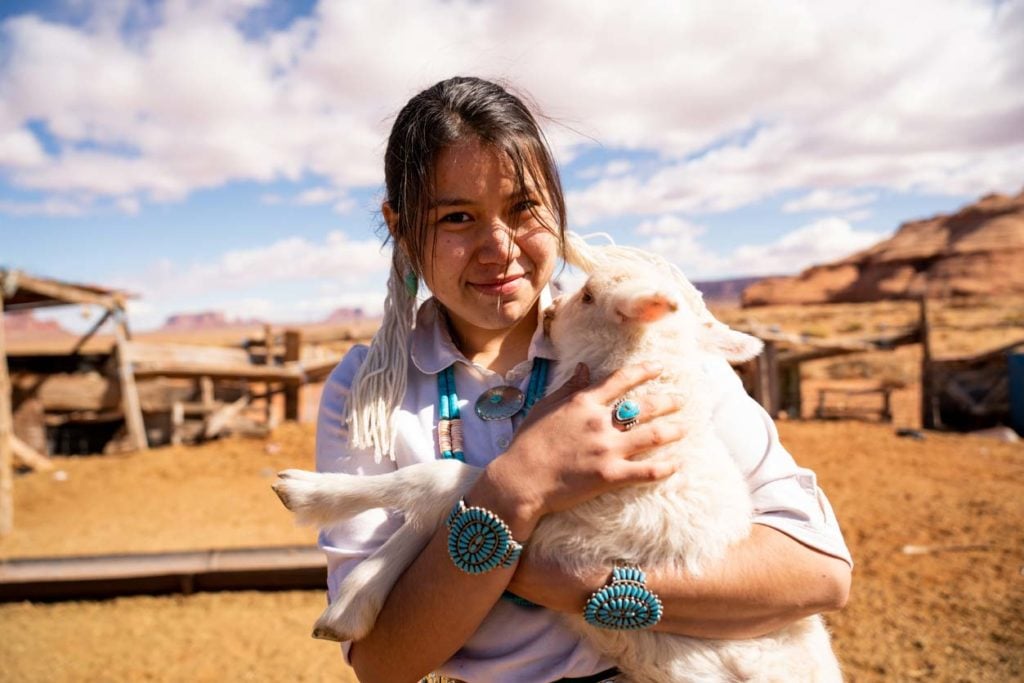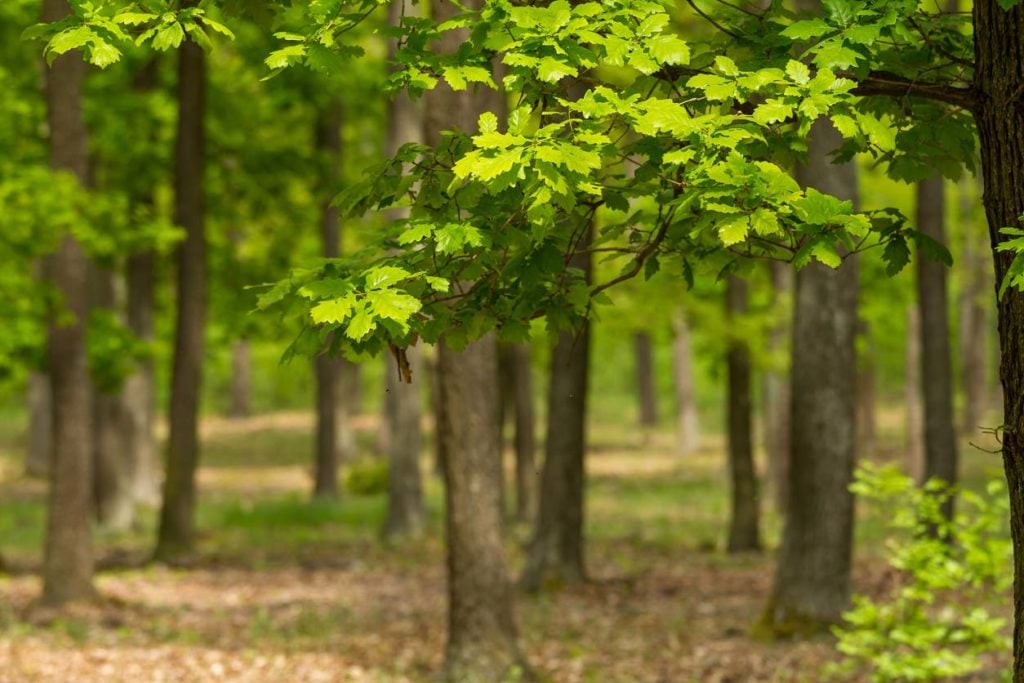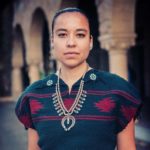By Lyla June — indigenous poet, musician, educator, anthropologist, activist, and community servant
Editor’s Note: The following article is an opinion-editorial (commonly referred to as an “op-ed”). While most of the articles posted on the Food Revolution Network site are ones we or our staff have written, the op-eds we publish are different. Since we didn’t write them, we can’t always vouch for, and may even not agree with, everything they say. However, we present them to you because we believe they make an important contribution to the conversation that promotes our mission of healthy, ethical, and sustainable food for all.
My Relationship with Food
View this post on Instagram
The squash blossom, a recurring image in Diné art and jewelry, is a part of the Diné traditional agricultural and food system. Lyla June on Instagram in honor of Mauna Kea.
Growing up, I was not connected to my food, even though my ancestors were. I ate from grocery stores, restaurants, a little bit of fast food… I ate your normal Bureau of Indian Affairs school lunch menu – and it was trash. They had all us little native kids drink milk at school even though we are genetically lactose intolerant. Like most, I survived on the colonized American diet.
When I was about 27, an elder came and told me that it was time to plant the seeds. It was time to burn around the oak groves again. It was time to transplant the kelp gardens to make room for herring roe and herring spawning grounds. It was time to replant the chestnut forests in the East; space them apart so disease would not wipe them out. It was time to clear the understory of the forests to make room for the deer again. It was time to cultivate corn that might be smaller in size but more nutrient-dense than what we eat today. It was time to harvest the saguaro seeds again from the cacti. It was time to pick berries again. It was time to propagate those bushes again so future generations would have more to harvest. It was time to regenerate the highly sophisticated food systems that we as indigenous peoples cultivated, and, through trial and error over many thousands of years, we had perfected.
Food is not a noun in our language. It is a verb because food is not a thing. It is a dynamic, living process that is constantly in flux. It was time to jump into those actions again.
Reclaiming a Relationship to the Land
There’s a longstanding myth that native people in North America were simpletons — primitive, half-naked nomads running around the forest, eating hand-to-mouth whatever they could find. That’s how Europeans portrayed and continue to portray us. It’s been that way for so long that even native people are beginning to believe it.
The reality is, indigenous nations on Turtle Island were highly organized. They densely populated the land and managed it extensively. And this has a lot to do with food because the motivation to prune the land, to burn the land, to reseed the land, and to sculpt the land, was about feeding our nations. Not only our nations but other animal nations as well.
Soil Cores in Human-Made Foodscapes

If you want to know what was going on in the land thousands of years ago, you drill a soil core down into the earth. These soil columns can be up to 10 meters deep, and with them, you can analyze the fossilized pollen of a specific place. From the bottom to the top, you can date each layer and determine when the pollen was deposited. They show evidence of fossilized charcoal, revealing how people would burn the land routinely and extensively.
There’s a soil core, from what is now called Kentucky, that goes back 10,000 years. It shows that from 10,000 years ago up to about 3,000 years ago, it was mainly a cedar and hemlock forest. Then, around 3,000 years ago, in a relatively short time, the composition of the whole forest changed to a black walnut, hickory nut, chestnut, and oak forest. Additionally, the pollen evidenced edible species like lamb’s quarters and sumpweed.
People who moved in 3,000 years ago radically changed the way the land looked and tasted. These are anthropogenic or human-made foodscapes, where inhabitants would shape the land in a non-dominating and gentle way.
Food Forests in Canada & the Amazon

Similarly, in the Amazon, there were food forests where soil cores revealed numerous varieties of fruit and nut trees. Studies show that human beings co-created the Amazon rainforest as we know it. They utilized terra preta, a soil modifying technology found near former human settlements, that’s known today as biochar. Terra preta generates deep, highly fertile soils that endure for thousands of years. Our best soil scientists are only now beginning to understand how it works.
Another example is in Bella Bella, Canada, on the Central Coast of British Columbia. Here kelp gardens are planted and cultivated by the Haítzaqv (Heiltsuk) Nation. Their kelp groves provide spawning ground for the herring, where they lay their eggs. Herring roe is crucial to the web of life in that ecosystem. The humans eat the roe. The wolves eat the roe. And the salmon that eat the roe feed the killer whales in turn. Everyone eats the roe, and everyone eats the things that eat the roe. Without this human touch along the coastline, the entire ecosystem would diminish.
Humans are a Keystone Species

What we’re finding, and what European scientists may be realizing, is that human beings are meant to be a keystone species. A keystone species creates habitat and living conditions for other species. If you remove or extirpate a keystone species, the ecosystem degrades and unravels. Wolves, beavers, sea otters, and grizzly bears are also keystone species because of the ecological role they play.
We are here for a reason. Every being is here for a reason — every rock, every deer, every star, every person. Creator does not make things without purpose or function, or that isn’t a piece of the larger puzzle.
Indigenous people are trying to bring the human being back into the role of the keystone species, where our presence on the land nourishes the land and its inhabitants. We can’t just sustain ourselves; that’s a low standard. We are going for enhanceability, as my friend Vina Brown calls it. This is the ability to amplify ecological health wherever I walk, the capacity to make the land better than I found it.
Indigenous Land Management

Where you live, which biome or ecosystem, will determine how you are meant to work with the land. For example, the Amah Mutsun Nation, which is indigenous to what is now called Santa Cruz, California, has a ceremony that they do with the oak trees. If you look at their oak trees, the bark is hard and fire-resistant. This is because they have been co-evolving with human fire for thousands of years.
The Amah Mutsun had a rule of thumb: only 14 trees per acre. Today, in California, you might see 200–400 trees per acre. The land can’t handle that. Those trees are stressed, if not starving, because there are limited nutrients and water in the soil. The Amah Mutsun people would create savannahs with larger, more abundant, and appropriately spaced oak forests to provide rich, green pastures in between for deer, elk, and other hoofed beings.
When European explorers first landed on the Eastern seaboard, they marveled at the forests and wrote how they looked like parks. There was space between the trees. There were deer walking through. They called this “wilderness” beautiful. But wilderness is a word that we need to examine and reconsider. If we call it wilderness, we separate ourselves from it, as if I am over here in the non-wilderness and real nature is over there in the real wilderness. And it may not be as “wild” as you think, as healthy ecosystems need the careful tending of human hands.
Controlled Burns

According to elders, the Amah Mutsun cut down the low-hanging branches of oak trees annually because they could catch fire. In the fall, they would gather the fallen leaves and burn a circle around the trees. They blessed the trees with the smoke, which would go into the leaves and inhibit or prevent tree disease. The bugs would fall into the fire ensuring a healthier acorn crop. And the competing saplings would be killed off so that only the hardiest and strongest plants would survive. Native tribes would do this throughout California — a gentle pressure that held order and health for all beings of the forest.
The forest needs us. We are here for a reason. These big brains aren’t an accident and can be leveraged to heal and enhance the land for all our relations.
The Restorative Power of Fire

The Great Plains with its tens of millions of buffalo were also anthropogenic. Meaning made by humans. People used to call the late summer “Indian Summers” because the sky would go darker due to the native-set fires. Without fire, the famed tall-grass prairies would have turned to scrub, forest, and inedible browse. And yes, we hunted buffalo — but we hunted them in the lush grasslands we made for them. We did not follow them. They followed us.
There is a term used for what we practiced in the Buffalo Commons: successive regrowth. If you burn an area it will grow back in stages. One year after the burn, a specific set of flora and fauna will emerge. Two years later, another set of flora and fauna emerge. Three years later, it will change again. And four years later, it will have further evolved.
There were always areas throughout the Great Plains in different stages of annual and perennial regrowth with a diverse set of flora and fauna. Thus, a mosaic of varying stages of regrowth quilted the Plains. And the overall biodiversity of that region was enhanced. This is the kind of genius our ancestors created through patient observation of land and place.
Reclaiming the Narrative of Native Nations
View this post on Instagram
Lyla June on Instagram on the subtext of Indigenous education, love.
But sometimes, even our own elders have told us native peoples are not as smart as other races. However, we have to understand that 98% of our people were wiped out before colonists started writing stories about us. Before they even started taking pictures. Every picture you see — the black-and-white daguerreotype and tintypes — were taken after at least 90% of the population was decimated by disease and massacre. Wisdom and knowledge were also lost and obliterated. All of those photos are false representations of great civilizations.
The native nations we know of today — Cherokee, Seminole, Cheyenne, Sioux — are survival bands. These are the two or less percent of native tribes that survived and got together to make things work. They do not reflect the original composition of the people. It doesn’t belittle the descendants; it is simply an invitation, a beckoning for the world to look deeper at the stories we have been told. The story that unfolded on this continent is far greater than what any of us now know.
The original composition of the people upon North America was vast, and it was highly organized. Archaeologists have a supposition that if there were vast populations, there would be marks on the earth that we could see today. But we did not leave marks on the earth that you could see hundreds of years later because we knew if you did that, you had done something disrespectful.
You could say we were the original “Leave No Trace” society. What we did leave in our wake, however, is biodiverse biomes. Much of that biodiversity survives and supports the Earth today. Much of it is being depleted. There is almost no record of our enormous populations other than oral histories, biodiverse food systems that the world eats today, and fossilized records found in things like soil cores.
Forests are Farms
View this post on Instagram
Lyla June on Instagram with sacred hickory nuts cultivated by Shawnee ancestors for over 3,000 years.
But it’s not what you do with food or forest, it’s why you do it. What you do will change from biome to biome; but why you do it should remain the same. You do it to honor what Creator has made. You do it to enhance the land you live on. You do it to diversify genes at every opportunity. You do it to honor the natural flow of water. You do it in the spirit of selflessness, in the spirit of service, in the spirit of community. And as long as you’re doing that, the technical skills will follow.
It’s hard to know what happened on this planet, and how it flourished – the civilizations that were once here. There were over 80 different languages spoken in California alone before European arrival. Extraordinary things happened within that diverse base of knowledge. Expanding your imagination about what happened will help us set the record straight about who was primitive and who was civilized – and will help us regenerate the world again.
Maybe by thinking about which seeds we plant. Maybe by trying to have twelve different kinds of squash, and twelve different kinds of corn in your garden. Maybe instead of cutting down a forest to make room for a farm, realize that the forest is already a farm. If you know how to take care of it, it will make food for you, better than any monocrop.
It is time for us to remember that a forest is a farm. And if it’s not a farm when you find it, then delicately, respectfully, and carefully turn it into a farm. Don’t cut it down.
Tell us in the comments:
- What most resonated with you in this article?
- What can you do to contribute to the “enhanceability” of land?
- Has your view of forests shifted? How will you see things differently the next time you walk in the woods?




